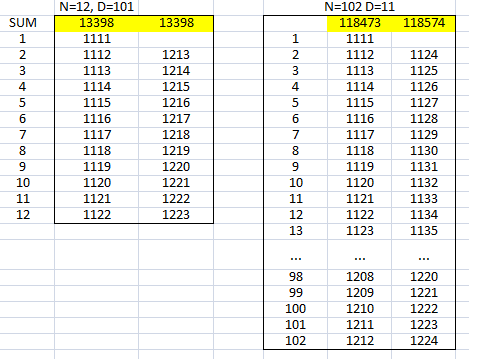AP train
An arithmetic progression is shifted and shortened, but its sum remains the same...
Problem
A particular list of $N$ consecutive integers starts with $1111$ as follows:
$$1111, 1112, 1113, \dots, 1111 + N-1$$
The entire list is shifted $D$ places along the number line and the first number then excluded, leaving a list of $N-1$ larger consecutive numbers as follows:
$$1112+D, 1113+D, \dots, 1111 + N -1+ D$$
In each list the sum of the integers is the same.
What are the possibilities for $N$ and $D$?
Did you know ... ?
Progressions of integers occur remarkably frequently in mathematics in applications from quantum mechanics to number theory and they have many beautiful properties. Even Carl Gauss, possibly the greatest mathematician of all time, fondly recalled his first encounter with sums of consecutive natural numbers, when he noticed that the sum of the first $100$ whole numbers equalled $50$ lots of $101$.
Student Solutions
Forming an equation using the amounts added and subtracted
To shift the sequence along $D$ spaces,
from $(1111)+ (1112)+( 1113)+, \dots, (1111 + N-1)$
to $(1111+D)+(1112+D) + (1113+D) + \dots+(1111 + N -1+ D),$
you add $D$ to each term, so you add it $N$ times, since there are $N$ terms.
That is the same as adding a total of $N\times D$.
Then removing the first term, $1111+D$, takes the sum back to its original value.
So $N\times D$ must be equal to $1111+D$.
$$\begin{align}ND&=1111+D\\\Rightarrow ND-D&=1111\\\Rightarrow (N-1)D&=1111\end{align}$$
$N$ and $D$ are both integers, so $N-1$ and $D$ must be factors of $1111$.
$1111=11\times101$, which are both prime, so all of the possible values of $N$ and $D$ are shown below:
| Product $(N-1)\times D =1111$ | $N$ and $D$ |
|---|---|
| $1111\times1$ | $N=1112,D=1$ |
| $1\times1111$ | $N=2,D=1111$ |
| $11\times101$ | $N=12,D=101$ |
| $101\times11$ | $N=102,D=11$ |
You can see some of these sums in action on the spreadsheet screenshot at the bottom of the page.
Using the formula for the sum of the first $n$ natural numbers
The sum of the first $n$ natural numbers is equal to $$
1+2+\dots + (n-1) + n =\frac{1}{2}n(n+1)
$$
Its easier in a problem like this to introduce some notation. Let's write $S(n)$ to mean the sum of the first $n$ natural numbers.
Since the two sums are equal we have
$$
S(1111+N-1)-S(1110) = S(1111+N -1 +D) - S(1111 + D)
$$
Let's put the formula into each of these and cancel each factor of a half.
$$
(1110+N)(1111+N)-(1110)(1111)=(1110+N+D)(1111+N+D)-(1111+D)(1112+D)
$$
Before leaping in we can see that many parts cancel, so we can put
$$
2221N + N^2 = 2221(N+D) + (N+D)^2 - 2223D - D^2- 2222
$$
Collecting things together gives
$$
D(N-1) = 1111
$$
Now for a bit of number theory: $1111 = 11\times 101$, or $1\times1111$. Thus, for solutions we require:
$D = 11, N=102$ or $D=101, N=12$ or $D=1,N=1112$ or $D=1111,N=2$.
You can see some of these sums in action on this spreadsheet screenshot

Teachers' Resources
Why do this problem?
This problem allows students to extend their understanding of arithmetic series in the context of an interesting challenge. They may choose to treat the sums of consecutive natural numbers as the difference between two triangle numbers, by using the formula for the sum of an arithmetic series or by using some algebraic intuition. The solution involves careful algebraic manipulation and some understanding of number theory, given that the unknown values must be natural numbers. Exploration with a spreadsheet could support those who find the algebra more difficult.
Possible approach
Ask students to write down a short sequence of consecutive natural numbers. Ask them to add up the numbers, suggesting different possible approaches to calculate the sum. Now ask them to add a fixed quantity on to each number in their sequence and then cross out the first number. If they add their new sequence of numbers, how does it relate to their original sequence?
Hopefully, there will be a range of examples reflecting cases where the new series is greater than, less than or equal to the original. If not all possible outcomes are represented, you could model the sequence {5,6,7,8,9,10,11} which after shifting all terms on by 1 and deleting the first term becomes {7,8,9,10,11,12}. It should be clear that the sum of the second series is larger than the sum of the first. However, if there had only been six terms in the first series {5,6,7,8,9,10}, leaving five in the second {7,8,9,10,11}, the two sums would have been the same. On the other hand, if there had only been five terms to start with {5,6,7,8,9} so that the adjusted series was {7,8,9,10}, the second sum would have been smaller than the first.
Once students have the idea of the transformation which takes the first series to the second, give them the actual problem. Ideally, they will approach this algebraically, but they could also experiment with spreadsheets to get a feel for the situation. They may get stuck when they realise that they have just one equation with two unknowns. Encourage them to think about the additional restrictions on N and D (i.e. that they must be natural numbers).
Key questions
How can we sum a series of consecutive natural numbers? Is there more than one way?
What restrictions do we have on the values of N and D? How does this affect our approach to solving for N and D?
Possible support
Students could use a spreadsheet to experiment with different values of N and D.
